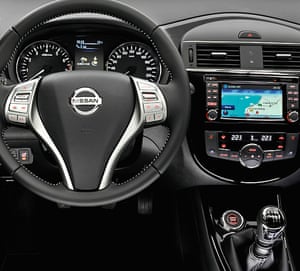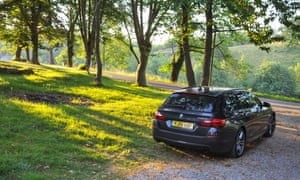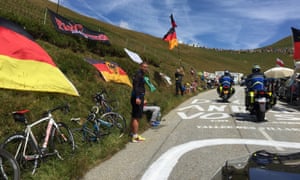On the road: Nissan Pulsar – <b>car review</b> | Technology | The Guardian |
- On the road: Nissan Pulsar – <b>car review</b> | Technology | The Guardian
- Apple Met With California DMV to <b>Review</b> Autonomous <b>Vehicle</b> <b>...</b>
- Porsche 911 GTS Carrera Cabriolet: <b>car review</b> | Martin Love <b>...</b>
- BMW 535d Touring: <b>car review</b> | William Fotheringham - The Guardian
- Long-Term <b>Car Review</b>: 2015 BMW i3 – final verdict | Driving
- On the road: Citro?n DS5 – <b>car review</b> | Technology | The Guardian
| On the road: Nissan Pulsar – <b>car review</b> | Technology | The Guardian Posted: 11 Sep 2015 10:00 PM PDT Nissan has been going through a phase of making cars that look like their internal organs are on the outside of their bodies (chief among them, the marvellously ugly Juke, which once you notice, you become fascinated by, like ugly babies). In the Pulsar, they bring us a car that looks like a car: they are obviously a bit embarrassed by that, which is why they gave me a red one (they think we're like bulls, and you hold our attention by waving a red thing at us: which in my case is broadly true). The look suited me fine: I prefer a hatchback to be sensibly close to the ground. The way they endlessly try to raise themselves above one another is vulgar. It has all kinds of nice finishes, from the classy textures on the ledge above the exhaust, to the alloy wheels, to the elegant fonts on all the displays. The boot looks large and is even larger, as I learned when I swapped cars while away and had to leave the dog in Kent (joking! I went back for him). It's not the most fun I've ever had in a car: the seats may be heated leather, but the driving posture is a bit upright and uninviting, like sitting on the Paris Metro. The 1.6-litre petrol engine was smart and credible in a town. You could nip in and out of lanes, parking spaces, other people's drives that expressly said "no turning". Plus, 7.7 seconds from 0-62mph is pokier than you'd expect, and sometimes, tricks you into zooming and tearing about, when all you had meant to do was mosey. On an A-road, its limitations were more obvious, though never howling; it has good grip but not the most responsive steering, smooth cruising, but not the most enthusiastic acceleration in the top gears. The handling is a bit creaky and stiff, like a person who leans because they have a bad back and don't want to reach; that makes it sound worse than it is. Think of a person with only a slightly bad back. It has a top speed of 135mph, so it's not that safety-first, though a lot of the jazzing up has been with a safety motive. The safety features – lane-departure sensor, blind spot detector, rear-end collision auto-braking, run the full gamut of preventative imagination, from "driver who's not really concentrating" to "driver who is playing Candy Crush and on drugs". The newest feature is moving-object detection, for the awful event in which you miss a child or a dog. Didn't use it; can't vouch for its efficacy; even if I had used it, wouldn't admit it. I never felt that I became part of the car, or that it was an extension of me. But I would admit it happily as a member of the family, which is roughly 80% of what a family hatchback hopes for.
Price £22,345 |
| Apple Met With California DMV to <b>Review</b> Autonomous <b>Vehicle</b> <b>...</b> Posted: 18 Sep 2015 04:48 AM PDT Apple senior legal counsel Mike Maletic held an hour-long meeting with the California Department of Motor Vehicles last month to review "autonomous vehicle regulations," according to internal documents obtained by The Guardian. The revelation comes amid widespread rumors that Apple has hired hundreds of employees to develop an electric vehicle over the past several months.
California DMV headquarters in Sacramento Maletic reportedly met with a trio of DMV executives familiar with self-driving cars, including deputy director Bernard Soriano and chief of strategic planning Stephanie Dougherty, who are co-sponsors of California's autonomous vehicle regulation project. Brian Soublet, the department's deputy director and chief counsel, was also in the meeting, according to the report. Apple would be required to obtain an Autonomous Vehicle Testing Permit from the California DMV to test autonomous vehicles on public roads, which Volkswagen, Mercedes-Benz, Google, Tesla Motors, Nissan, BMW, Honda and others have already done. Given the Cupertino-based company's culture of secrecy, however, that is an unlikely scenario. If rumors about Apple testing an electric vehicle are true, it is more likely that the iPhone maker will use a private testing facility such as GoMentum Station, a 2,100-acre former naval base in the San Francisco Bay Area run by the Contra Costa Transportation Authority. Apple could also use its own property to test vehicles with complete privacy, something it may already be doing. Apple's rumored "Project Titan" electric vehicle research and development could be based at a top-secret office and lab complex in Sunnyvale codenamed SG05, the report corroborates. Bloomberg reported in February that Apple aims to begin electric car production as early as 2020, but the company's roadmap is not entirely clear due to the highly secretive nature of the project. |
| Porsche 911 GTS Carrera Cabriolet: <b>car review</b> | Martin Love <b>...</b> Posted: 12 Sep 2015 09:59 PM PDT Road runner: the 911 is one of the world's mosty celebrated sports cars – but think carefully about the colour. Price: £99,602 Opening up Porsche's fabulously rorty engine and letting its distinctive exhaust note engulf you is one of motoring's most celebrated experiences, a journey into automotive nirvana… Well, that's the theory anyway. Truth is, like teenagers and hairy pets, you often have to work hard to see the good in a Porsche. First up there is the nose-bleeding price tag. You'll get just £398 change from £100K for this 911 GTS – fill it up a couple of times and you're there. Second, everyone hates you – even more than usual. In the week I spent with this car (yellow and a soft top was fuel to the flame), I was the victim of three cases of road rage (there was a fourth but that one was deserved). All involved liberal use of the words "twat" and "wanker". Maybe Porsche should trademark them, as people seem to think that's what the cars are called. Then there's the drive. In an ideal world we'd only travel on empty winding roads with challenging cambers and stunning views. But life's not a driving game, sadly, and nose-to-tailing in the 911 is like giving your left calf an extreme work out – the clutch is sprung like a mantrap. On top of that there's the ludicrous seven-speed gearbox with a gate so narrow you are forever jamming it into the wrong gear. Without the finessing effect of speed, the car feels cumbersome and a fatiguing drive. But (and it's a but that's enraptured Porsche zealots for decades) when you do finally hit that open road, open up the roof and open up the rear-mounted flat-six… Well, oh my. It's properly amazingly awesome. This 911 was unveiled at the Los Angeles Auto Show last November and its cabriolet sister has now been rolled out to match the coupé. With the soft top up, both cars share the same legendary silhouette. The 3.8-litre engine is the 911's defining characteristic and it pumps out 424bhp, does 0-62mph in 4.6 seconds and tops out at 188mph. The electric steering delivers superb feedback so you can feel your way in and out of corners with surgical precision. With the cabriolet you can drop the top and truly revel in the car's performance. Everything about the car is quick: it only takes 13 seconds to open the roof and you can do it at up to 35mph. The boot is pathetic, but there are two unexpectedly large rear seats for baggage – or people. I squeezed a 6ft friend, his dog and his injured son in there to drive them to hospital for an x-ray. The boy claimed he'd been "saved by Porsche" – a future sale in the bag for the German marque. Email Martin at martin.love@observer.co.uk or follow him on Twitter at @MartinLove166 |
| BMW 535d Touring: <b>car review</b> | William Fotheringham - The Guardian Posted: 05 Sep 2015 10:00 PM PDT Touring on Tour: the sleek BMW 535d M. Price £45,320 It's Tour of Spain time and the Tour of Britain is round the corner, but one memory from July's Tour de France sticks in my mind. As I drove up the A6 through Burgundy having spent weeks trailing the peloton through the Pyrenees and the Alps, I spotted a figure on a bridge. As I passed he started waving wildly at me. Had he spotted the race sticker on my windscreen or did he like the look of the BMW I was driving? Or both? The new 535d M Touring is an imposing machine which we nicknamed the Big Mean Wagen. (The endless hours driving from stage starts to press rooms at the finish are a true spur to the creative mind.) The vast bonnet was intimidating enough to scare most other Tour traffic, and out back, the car's rear load space had ample space for the "Killer", a bike I take on Tour to explore France in the odd off-duty hour. This is an acid test I apply to estate cars at the race as most have back ends which look far more capacious than they are in reality.
The BMW was a good place to spend hour after happy hour flogging French roads in pursuit of Chris Froome and company. Its advanced aerodynamics make it astonishingly silent – until you engage Sport mode at which point it emits a Clarkson-pleasing howl – and the headroom is plentiful even for a six-footer like me. The Tour's top brass judge their cars by the size of the sunroof; the BMW's would have been big enough to enable a whole family to enjoy the mountain breeze in their hair had we not chosen to close it and cower from the heat of one of the hottest French Julys on record. Impressively for a machine weighing nigh on two tons, there is no stodge or slop in the handling no matter how tight the hairpin or bizarre the camber. Somehow BMW has created a machine which feels totally in touch with the road. It is massively powerful and whizzes up mountains, but the fuel economy depends how you use that power. A single tank of diesel took me all the way from Le Havre to the Pyrenees in Comfort mode, but once into the mountains and using the Sport setting for the automatic gearbox, the fuel gauge headed west with startling rapidity as the Tour went east.
With high-spec cars, much of the pleasure – or stress – comes from how the extras fit into the driving experience. Here the BMW took a bit of getting used to. It is disturbingly easy to engage neutral by mistake if you rest an idle hand on the joystick. Germany fell out of love with the Tour in the mid-2000s after the endless series of drugs scandals, but the romance was rekindled recently thanks to stars such as Marcel Kittel, Tony Martin and André Greipel.
It's fun finding a parallel for a Tour car among the race's cyclists. For speed out of the blocks, sustained power and moody looks, this one was Greipel, the four-times stage-winning sprinter nicknamed the Gorilla of Rostock. For surprising zip up a mountain and sure-footedness down the other side, the bearded Simon Geschke, a surprise stage winner in the Alps. The Big Mean Wagen is a machine with multiple identities, consummate power and, like the Germans in France this year, a winning formula.
|
| Long-Term <b>Car Review</b>: 2015 BMW i3 – final verdict | Driving Posted: 17 Sep 2015 06:32 AM PDT Overview2015 BMW i3 BMW's first all-electric production car is a technological tour de force Pros Supercar high-tech for mainstream money, athletic road manners, aesthetically pleasing interior Cons Two-tone exterior, small REX fuel tank, suicide doors Value for money Good What would I change? Offer monochromatic exterior options, front-hinging rear doors and one more rear seat How I would spec it? I'd skip the expensive connectivity features and range-extender to keep the price under $50K Abraham Lincoln once said, "The best thing about the future is that it comes only one day at a time." And in the case of our 2015 BMW i3 Range Extender (REX) electric car, we had 60 days to experience what many believe is the future of motoring. Beyond being the German automaker's first-ever, pure-electric production vehicle, the i3 compact hatchback (which starts at $47,395, including freight and predelivery inspection fees) is the tip of the wedge for BMW's all-new i brand, which also has the i8 ($152,095) plug-in gas-electric hybrid 2+2 sports car in its barn, with both vehicles representing a whole new way of building, marketing and selling cars for the automaker. Taking up about the same amount of space in your garage as a typical small car, the four-passenger, i3 veers hard from the norm with rear-wheel-drive, a plastic-panel-wrapped carbon fibre and aluminum structure, creatively designed interior—and in the case of our i3 Range Extender (REX) tester—up to 130 kilometres of gas-free driving and around another 90 km using a small, gasoline motor to charge the batteries on the fly.  The 2015 BMW i3. Somewhat overwhelmed by the BMW's uniqueness, we wanted to answer a few questions that a typical weeklong test drive would not encompass. What would the i3 be like as a daily driver, both from the driver's seat and as a people and stuff hauler? How easy would it be for BMW's futuristic electric car to be integrated into today's immature electric charging infrastructure? And, most importantly, is "the future of motoring" all it's cracked up to be? Whether powered by a straight-six gas engine, a battery pack or pixie dust, any BMW wearing the brand's well-known flying blue propeller logo and twin-kidney grille is expected to offer a premium driving experience. And over the course of our two months with the i3 REX, the small electric vehicle (EV) did not disappoint. Combined with its lightweight body, the i3 REX electric motor's 170 horsepower and 184 pound-feet of torque serenely zips the small car to 100 kilometres per hour in a relatively quick 7.9 seconds. (The lighter battery-only i3 is 0.3 seconds quicker). Plus there's no shifting involved, as the i3 uses a single-gear direct-drive transmission. As an urban traffic assault vehicle, the i3 REX shines. It nips in and out of traffic like a four-wheeled scooter, with quick steering that gives more feel than most front-wheel-drive compacts. And even with relatively narrow tires (designed for low-resistance) the i3 has plenty of grip.  2015 BMW i3 Where the i3 goes like a 3 Series sedan, the way it stops needs some getting use to. The i3's regenerative energy brakes decelerate so quickly the car can slow all the way to a stop by simply lifting off the throttle. In around town driving, you can essentially drive with only one foot on the accelerator, letting the re-gen brakes slow the vehicle down at stoplights and corners. If the i3 does the job mimicking a "normal" BMW when it come to its driving characteristics, the EV's cabin is truly unique. And after eight weeks, we think it's for the better. For starters, the i3's carbon-fibre upper body allows for better visibility and more available space than comparably sized compact cars or crossovers. There's plenty of glass to see out of, and the vehicle's flat floor allows for some unexpected extra storage space between the front seats. And while the rear cargo space behind the rear seats is not deep due to the rear placement of the drivetrain, we quite often folded the rear seats for our golf clubs or ringette equipment bags to easily fit.  The 2015 BMW i3. That said, the use of rear-hinged rear doors on the i3 seems more like a gimmick than a solution. Like the same complaint with other vehicles with this setup (see Honda Element), having to open the front doors before the rear is a pain. Where BMW has nailed it, though, is the architecturally inspired design of the i3's cabin. The pair of large, "floating" digital screens handle the majority of the functions and gives the car a futuristic yet functional feel. Contrast to all of these futuristic features, because of the way it drove and felt, it was easy to forget the BMW i3 REX was only being powered by electricity. But after two or three days of urban errand running and trips to the outer edges of suburbia (instead of the week or so between fill-ups for our family's gas-powered Audi Q5), the need to find some place to plug-in the i3 would arise. Which is why having a Level II home charging unit is almost a "must have" for an electric car like the BMW. Installed on the outside wall of our home, the BMW-branded unit allowed us to charge the i3 whenever it was not in use, and could be programmed via a smartphone app for less expensive off-peak electricity rates.  The 2015 BMW i3. Due to my work-at-home status, Ottawa's relatively small geography, and not using the BMW as our family's primary mode of transport, in total, we only drove the i3 REX 1,342 kilometres. The maximum distance on one charge was 102 kms. On average, the car consumed 15.8 kWh/100 km; just below the 16.0 average other BMW i3 owners achieved according to info provided by the BMW i app. The app also said the car recuperated 5.3 kWh/100 km on every trip, on average. And take this for what it is, but we also "saved" 253.2 kilograms of CO2 if our electricity came from 100 per cent renewable energy sources, or 43.0 kg if from conventional energy, if compared to a comparable gas car. As much as BMW has made the most of available technologies to maximize the i3's driving range, any EV owner looking for power away from home still faces many hurdles in Canada due to this country's immature recharging infrastructure. That means if we wanted to make the 450 kms drive from our home in Ottawa to downtown Toronto in the i3 REX, after the batteries ran out about half-way, we could either look for a Level II charger and wait for a couple of hours for a recharge, or continue driving using the range extender engine. But with its fuel tank holding only nine litres that would mean stopping for gas every 90 kms. Possible, but not very convenient if you are relying on the i3 as the only vehicle in your fleet. Yet that reason alone is not reason enough to take the BMW EV off your next new vehicle wish list. Despite its obvious range limitations, we would be happy to sign up for a longer stay than the mere 60 says we had in the i3 REX.  2015 BMW i3 REX With its exotic-material body, stylish interior and cutting-edge powertrain, even at its $60,195 as-tested price, the 2015 BMW i3 REX delivers supercar technology for the price of a midsize luxury sedan. Its quiet, roomy, stylish and functional interior is much more relaxing to be in than the typical compact car. However, if BMW is reading this, we think a more conventional exterior styling, a larger fuel tank for the REX option and a rethink of the side door design would broaden the BMW EV's appeal even more. As the inventor of the battery-powered electric starter, Charles F. Kettering once said "my interest is in the future because I am going to spend the rest of my life there." For buyers who want can't wait for the future, the 2015 BMW i3 REX is available right now.  The 2015 BMW i3.
|
| On the road: Citro?n DS5 – <b>car review</b> | Technology | The Guardian Posted: 04 Sep 2015 09:59 PM PDT They call it "ink blue"; I call it indigo. The DS5 has sharp, aggressive styling at the front, and it has separated itself from its Citroën branding, so that its identity is conveyed by a funny, squiggly swoosh on the rear. My father-in-law looked askance at this, as if it were a recalcitrant adult child trying to divorce its parent. But I thought it looked chic and modern: goodbye, boring colours and marques; hello, the colour of midnight and the world of the post-marque. Then I got in. The cabin is fine: in the Prestige version, which I had, you can electrically control your driver's seat, but you can't electrically control the firmness of the ride, or the way the poky gear shifts bring out the racer in you. Nor would you want to: that's the entire point of buying it, because, at £30,000, this is neither the thriftiest nor the most responsible car in its compact-exec class. The parking camera was one of the best on the market (sounds like a small thing, but often they're set to be incredibly melodramatic, sounding the alarm when you're metres away from anything, so that you finish every journey in a state of mild panic). The controls were intuitive and the finish is high-spec and polished. It felt roomy in the front, though some pesky adults complained about headroom in the back, and boot space was ample. Visibility was terrible: the front struts interfered with my peripheral vision. I couldn't tell whether I was approaching a tree, a pedestrian or the frame of my own car, which made my urban driving extremely timid and obviated the beefy engine entirely (this was a 150; there's a 180, too). Maybe this was deliberate on the part of the designer, to introduce more caution to the whole driving culture: like Copenhagen crossings, in which the pavement and the road are deliberately ambiguated to make people slow down. My sister says it's like using children as bollards. There's also an inexplicable horizontal strut across the back, which I didn't mind in town, but interfered with rear visibility and was maddening on a motorway. There's an argument that you adjust to anything over time, but an adjustment that takes longer than a week is a mistake. Once you lighten up and stop worrying about seeing all the other cars, you will notice how much fun there is to be had in the upper gears. Zero to 62mph isn't, at over 10 seconds, particularly impressive, but there's lots of range in fourth and fifth gears (nothing in sixth, but fair enough), and overtaking is a pleasure. Indeed, there's plenty to like about it: it has stamina but it's also nippy, it's smooth and soundless, but with a rough, diesel-y edge. Maybe it's a bit niche, but there will be people in this car's bracket who spend their lives trying to look niche. Price £31,160 |
| You are subscribed to email updates from car review - Google Blog Search. To stop receiving these emails, you may unsubscribe now. | Email delivery powered by Google |
| Google Inc., 1600 Amphitheatre Parkway, Mountain View, CA 94043, United States | |






No comments:
Post a Comment